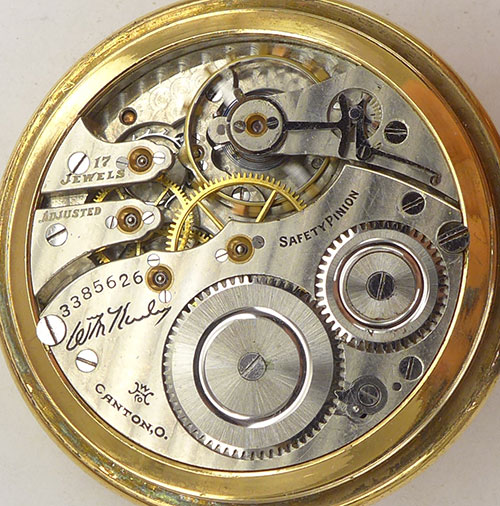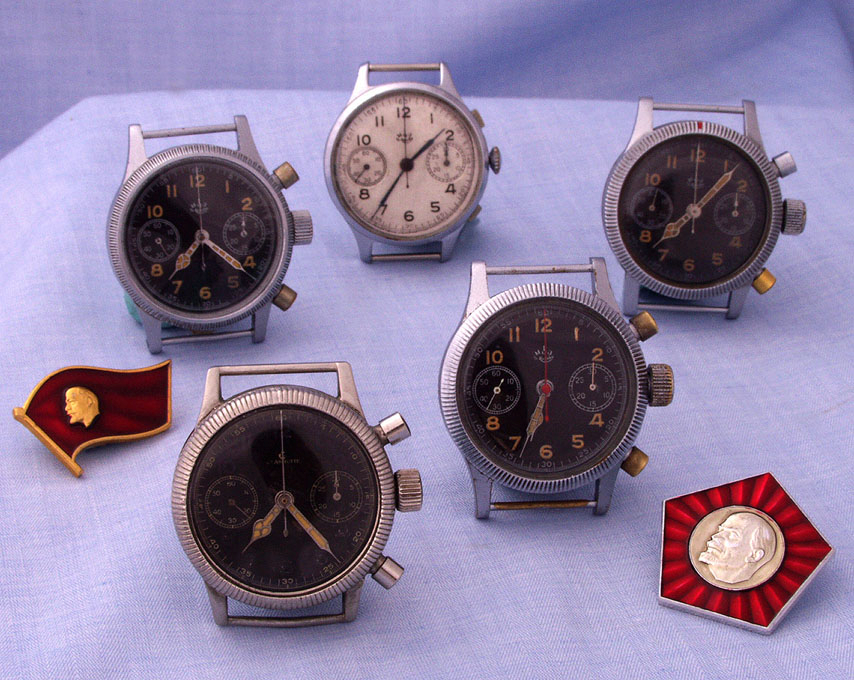Russian Watches Part 2: The First Moscow Watch Factory (Poljot)
By: Kaz Mirza
Nothing in Russian watch history is as important as the creation of the First Moscow Watch Factory (sometimes called the FMWF). From planning to construction, there were so many roadblocks, political cockblocks, and general goddam craziness that someone could write an Odyssean epic about its creation. Luckily, someone did – Alan F. Garratt chronicles the creation of the FMWF in a way that’s engrossing and extremely informative. I’ll recommend his site (Birth of Soviet Watchmaking) to anyone looking for additional information on the FMWF. But in the interest of brevity I’ll be focusing on the basics of the factory’s initial creation and then I’ll be shifting focus towards its strongest contribution (IMO) to USSR watches, the Soviet chronograph. That being said, this segment is really meant to act as an overview/quickstart guide for those interested in vintage USSR Watches, so there may be parts where seasoned USSR watch collectors will feel like I can expand on, and I totally agree. What I’ll be doing is creating individual articles that correspond to pieces that can be elaborated on during this entire series. Now, on to the First Moscow Watch Factory.
A lot of what the FMWF has to do it had to do from scratch. They didn’t have the proper equipment; they had very few trained technicians; and they had no trusted allies in any adjacent countries to trade with. So, the Russian government looked somewhere pretty unlikely to make their watch factory dreams come true: Canton, Ohio, USA.
In 1930 the Dueber-Hampden Watch Factory in Ohio put themselves up for sale due to a weak market for the pocket watches they were producing. I can’t imagine the reaction of everyone in the factory when a delegation of Russian Government officials offered to purchase their patents, equipment, and remaining materials. But more than that, the Russians also included a request for 21 Dueber-Hampden employees to travel to Russian in order to oversee both the installation of the equipment and the education of the Russian watch technicians. The Americans spent a year in Moscow helping to set up the FMWF. Interestingly, since the area of Canton, Ohio was primarily populated with German immigrants, the American watch technicians either knew how to speak German or had enough to get by. They probably didn’t realize that knowing German would help them communicate with the Russians they were training. The Americans didn’t know Russian and the Russian technicians didn’t know English, but both knew German. So that’s what the Americans mainly used to teach the first technicians of the FMWF.
Once established, the FMWF proudly made watches for both the everyday common person and the military (primarily as gifts and commemorative items). The first watches that the First Moscow Watch Factory created were pocket watches and they were very celebrated by the Russian people – those watches were basically a symbol of what the entire communist government wanted to embody: self-reliance. These pocket watches were made by Russian hands and on Russian soil. This initial pocket watch was called the Type-1 (also known as K43). The movement in this watch would basically be in use until about the 80s. The inspiration for this movement was the Dueber-Hampden “Size 16.” This is really important to note because the Russian version of the Size 16 inherited the American counterpart’s most distinct feature: the two-piece, forked balance bridge. The images you see below are from Alan Garrat’s webpage linked above. The first image (#1) is of the Dueber-Hampden Size 16 movement. The second image (#2) is the K43 developed by Russia. The forked balance wheel bridge has been highlighted in both shots. Please note that both of these are from Alan F Garratt’s personal collection and they were sourced from his work the “Birth of Soviet Watchmaking” – can’t emphasize this enough: visit that site. It’s incredible.
-#1

-#2:

For about 30 years the FMWF produced watches for the Russian people from the young to the old – military or civilian. But as these things usually tend to unfold, fairly quickly Russia began to notice a gap that was holding it back from it’s goal of being the most industrialized nation on the planet. It realized that it’s economic competitors had years and years of experience on them in regards to manufacturing one very specific piece of equipment that acted as an invaluable technical precision device: the chronograph. This brings me to what I believe was the greatest contribution of the First Moscow Watch Factory to the world of Russian watches: Soviet Chronographs.
The Tutima Flyback Chronograph:

Most folks will say the first Russian Chronograph ever produced was the Strela 3017, and they would be sort of right. I say “sort of” because Russia actually did produce (sort of) a chronograph before – the Tutima Type 59. Ok, so if you know Tutima you’re probably saying “Kaz, you asshole! Tutima is a German brand!” Well, asshat, you’re right – and so am I! During WW2 the German Tutima Chronograph (pictured above) was a highly coveted piece by Russian soldiers who happen to be lucky enough to pick them off crashed German pilots. The Tutima factory was located in Glashutte, East Germany. That’s right, the part of Germany that the Soviet’s occupied at the end of WW2 (you know, the Berlin Wall and all that). Well, I can only imagine how excited the Russians were when Glashutte ended up on their side of Germany because almost immediately the machinery from Tutima was seized along with the materials and existing stock. Everything was taken to the FMWF as the Russians claimed they were part of war reparations. There, the Russians created their own Tutima Flyback Chronograph with the FMWF markings. For a more in-depth explanation I recommend checking out this WUS thread by Mark Gordon, which is also my source for the image of the Tutima Chronograph’s above.
Strela 3017:

In 1951 production of the Tutima ceased only to be replaced by the Strela 3017 (the image of the 3017 above was taken from the current official site of Strela, which seems to be under German ownership – it’s complicated). The Strela 3017 is a two-register column wheel chronograph first produced in the 50s. Much like the creation of the FMWF itself, the Russians purchased the patents and equipment for the Venus 150 from the Swiss. Shortly afterwards the Strela 3017 was born and went into production. The dial designation and configuration of the 3017 has varied throughout the years, bearing the name Poljot and Sekonda in addition to Strela. Most notably, Cosmonaut Alexei Leonov wore a 3017 during his first space walk. The fate of the 3017 and it’s time at the FMWF would be sealed when its replacement was created, the Poljot 3133.
Poljot 3133

The 3133 is based off of the Swiss Valjoux 7734, which the Russians purchased the rights to produce in the late 70s. The 3133 made its debut in the Okean, which was first produced for the Sojuz-23 space station at their request for better technical equipment. The 3133 is a CAM operated two register chronograph that measures in increments of 45 minutes. It’s pretty distinguishable by it’s unique case shape in addition to the dial and the interior rotating bezel.
I’m working on a comprehensive guide specifically for authenticating and dating Poljot 3133s you may find online. We basically get people asking us every week to help them authenticating a listing they found – so creating a guide seemed like it would benefit a lot of folk. However, until the time when I’m able to write that guide I’ll recommend the guide on Polmax3133 to anyone interested. The guide there is extensive, but not easy to navigate and it’s sometimes a bit hard to follow. But until I write my own, it’ll do.
Current State of the First Moscow Watch Factory:
The current fate of the First Moscow Watch Factory is a bit vague. After the fall of Soviet Union the decline of Poljot began despite strong efforts to compete with the global market. It wasn’t until about the late 2000s that part of Poljot was acquired by part of a luxury conglomerate; the other part of the factory was actually purchased by a group of former Poljot employees. These employees essentially started a company called Volmax, which continued to create pieces with the “Sturmanskie” dial designation in addition to dial designations “Buran” and “Aviator.”
But then it gets even harder to understand. Post 2010 the luxury brand that purchased part of Poljot went bankrupt, and the group of former Poljot employees that created Volmax moved to Switzerland. These new Swiss-Made pieces are heavily reliant on the 3133 caliber (you can even see 3133s with new complications like moonphases). So it seems like the machinery to create the original 3133s was moved to Switzerland, which presents an interesting question. Is the brand really Russian anymore? It’s complicated and it’s honestly a bittersweet ending to an amazing brand. What started as a strong presence in the Russian horology world, kinda puttered into obscurity. As always, any new or additional info I learn will be included in this piece – this whole series is really meant to act as a living, organic document.
But not all of the USSR Horology Giants faded into obscurity. Some of them thrived during the Soviet Union and then continued to do very interesting things that gained a lot of enthusiasts’ attention to the point where they’re still a commonly known name. One such brand is Vostok – and that’s who we’ll be talking about next.
Read on to Russian Watches Part 3: The Chistopol Factory (Vostok)

Co-Founder and Senior Editor
Kaz has been collecting watches since 2015, but he’s been fascinated by product design, the Collector’s psychology, and brand marketing his whole life. While sharing the same strong fondness for all things horologically-affordable as Mike (his TBWS partner in crime), Kaz’s collection niche is also focused on vintage Soviet watches as well as watches that feature a unique, but well-designed quirk or visual hook.

It all started in Canton, Ohio,